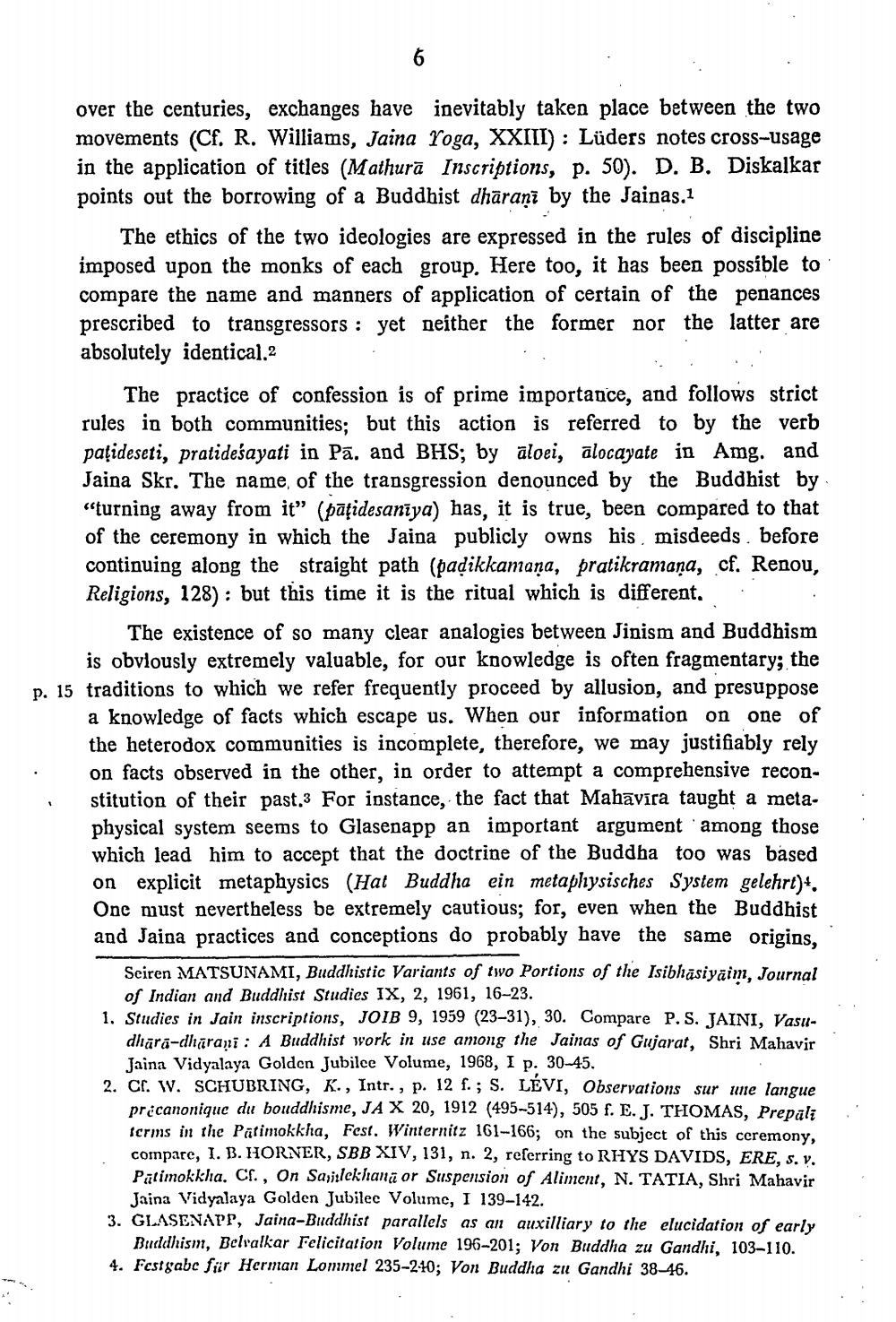________________
6
over the centuries, exchanges have inevitably taken place between the two movements (Cf. R. Williams, Jaina Yoga, XXIII): Lüders notes cross-usage in the application of titles (Mathura Inscriptions, p. 50). D. B. Diskalkar points out the borrowing of a Buddhist dharani by the Jainas.1
The ethics of the two ideologies are expressed in the rules of discipline imposed upon the monks of each group. Here too, it has been possible to compare the name and manners of application of certain of the penances prescribed to transgressors: yet neither the former nor the latter are absolutely identical.2
The practice of confession is of prime importance, and follows strict rules in both communities; but this action is referred to by the verb patideseti, pratideśayati in Pa. and BHS; by aloei, alocayate in Amg. and Jaina Skr. The name of the transgression denounced by the Buddhist by "turning away from it" (pațidesaniya) has, it is true, been compared to that of the ceremony in which the Jaina publicly owns his misdeeds. before continuing along the straight path (padikkamana, pratikramana, cf. Renou, Religions, 128): but this time it is the ritual which is different.
The existence of so many clear analogies between Jinism and Buddhism is obviously extremely valuable, for our knowledge is often fragmentary; the p. 15 traditions to which we refer frequently proceed by allusion, and presuppose
a knowledge of facts which escape us. When our information on one of the heterodox communities is incomplete, therefore, we may justifiably rely on facts observed in the other, in order to attempt a comprehensive reconstitution of their past.3 For instance, the fact that Mahavira taught a metaphysical system seems to Glasenapp an important argument among those which lead him to accept that the doctrine of the Buddha too was based on explicit metaphysics (Hat Buddha ein metaphysisches System gelehrt)+. One must nevertheless be extremely cautious; for, even when the Buddhist and Jaina practices and conceptions do probably have the same origins,
Seiren MATSUNAMI, Buddhistic Variants of two Portions of the Isibhasiyaim, Journal of Indian and Buddhist Studies IX, 2, 1961, 16-23.
1. Studies in Jain inscriptions, JOIB 9, 1959 (23-31), 30. Compare P. S. JAINI, Vasudhara-dharani: A Buddhist work in use among the Jainas of Gujarat, Shri Mahavir Jaina Vidyalaya Golden Jubilee Volume, 1968, I p. 30-45.
2. Cf. W. SCHUBRING, K., Intr., p. 12 f.; S. LEVI, Observations sur une langue precanonique du bouddhisme, JA X 20, 1912 (495-514), 505 f. E. J. THOMAS, Prepali terms in the Patimokkha, Fest. Winternitz 161-166; on the subject of this ceremony, compare, I. B. HORNER, SBB XIV, 131, n. 2, referring to RHYS DAVIDS, ERE, s. v. Patimokkha. Cf., On Samlekhana or Suspension of Aliment, N. TATIA, Shri Mahavir Jaina Vidyalaya Golden Jubilee Volume, I 139-142.
3. GLASENAPP, Jaina-Buddhist parallels as an auxilliary to the elucidation of early Buddhism, Belvalkar Felicitation Volume 196-201; Von Buddha zu Gandhi, 103-110. 4. Festgabe für Herman Lommel 235-240; Von Buddha zu Gandhi 38-46.




